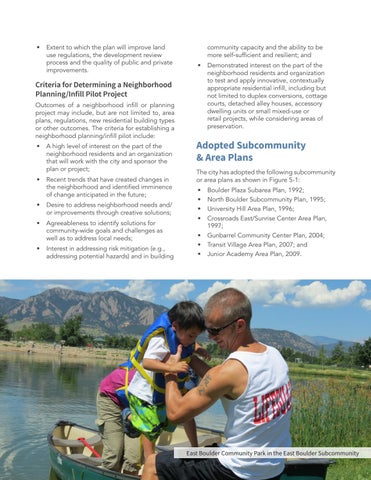• Extent to which the plan will improve land use regulations, the development review process and the quality of public and private improvements.
Criteria for Determining a Neighborhood Planning/Infill Pilot Project Outcomes of a neighborhood infill or planning project may include, but are not limited to, area plans, regulations, new residential building types or other outcomes. The criteria for establishing a neighborhood planning/infill pilot include: • A high level of interest on the part of the neighborhood residents and an organization that will work with the city and sponsor the plan or project; • Recent trends that have created changes in the neighborhood and identified imminence of change anticipated in the future; • Desire to address neighborhood needs and/ or improvements through creative solutions; • Agreeableness to identify solutions for community-wide goals and challenges as well as to address local needs; • Interest in addressing risk mitigation (e.g., addressing potential hazards) and in building
community capacity and the ability to be more self-sufficient and resilient; and • Demonstrated interest on the part of the neighborhood residents and organization to test and apply innovative, contextually appropriate residential infill, including but not limited to duplex conversions, cottage courts, detached alley houses, accessory dwelling units or small mixed-use or retail projects, while considering areas of preservation.
Adopted Subcommunity & Area Plans The city has adopted the following subcommunity or area plans as shown in Figure 5-1: • • • •
Boulder Plaza Subarea Plan, 1992; North Boulder Subcommunity Plan, 1995; University Hill Area Plan, 1996; Crossroads East/Sunrise Center Area Plan, 1997; • Gunbarrel Community Center Plan, 2004; • Transit Village Area Plan, 2007; and • Junior Academy Area Plan, 2009.
East CHAPTER Boulder Community Park in the EastPLANNING Boulder Subcommunity V SUBCOMMUNITY & AREA 112
